(Updated with full evaluation of Gignoux Fixation (binding) Ultimate 2)
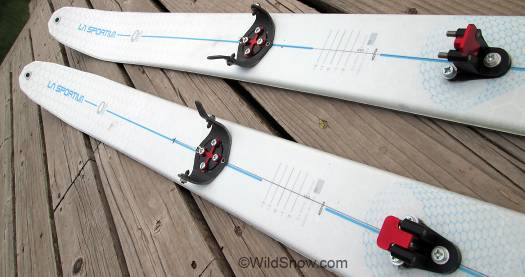
Sportiva Nano 180 cm saddled with Pierre Gignoux micro thong bindings (92 grams per binding, with screws).
1286 grams per 180 cm ski, with binding, 130/103/120. He he, hah hah hah, giggle giggle.
The Gignoux Fixation (binding) Ultimate 2 reminds me of the first time I owned a car with computerized fuel injection. So simple, yet complex under the surface. One of the most important things my first evaluations revealed is the Ultimate truly has nearly neutral delta when used with conventional AT boots in downhill mode (company literature says the only boot for this binding is the Gignoux, so consider all this a test).
While some of you might like having much less delta, for me it’s too radical of a departure from the Dynafit TLT standard delta I tune all my bindings to. In numbers, the difference between toe and heel heights of the Gignoux is 7.2 mm lower at the heel than a Dynafit TLT. (Note that due to how the Gignoux boot is shaped, you end up with more delta and heel lift in touring mode than you do with a conventional AT boot).
Along those same lines, if you’re used to standard touring bindings, when using boots other than the Gignoux carbon models you’ll find the Gignoux binding has nearly zero heel lift in climbing mode (red “flap” folded over heel pins.) With a 7 mm shim under the heel the binding could perhaps perform in normal touring, but in stock form the lack of heel lift made things quite difficult. That’s an observation, not a criticism, as this is a race binding and as such does not emphasize steep skin climbing. What’s more, the Gignoux boot does jack your heel up a bit higher than the TLT6 shoes I set these up for, though not to the extent of higher heel lifts on most touring bindings.
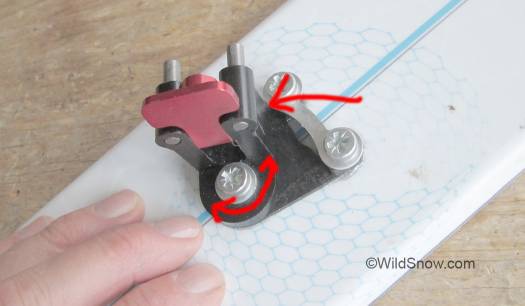
Gignoux heel unit (1 binding, 40 grams with screws). Lateral (side) release is accomplished by the upper part of the unit rotating against the lower, with a sort of “loaded friction” occurring as the upper rides past two plastic lobes on the base. Double arrow indicates rotation, single arrow points to one of the lobes with the upper riding it. Upwards (vertical) release occurs by virtue of the heel pins spreading as with most tech bindings. Only in this case the pins spread simply by distortion of the plastic risers they’re mounted on. Release values felt in hand testing to be around 8, neither are adjustable in of themselves, but choosing to lockout rotation of toe turntable (see next photo) changes lateral release value depending on type of boot. For example, a boot with conventional (Dynafit spec) tech fittings will release out of the toe with the turntable fixed, while a Gignoux boot has toe fittings that are not designed to release unless the binding toe can rotate.
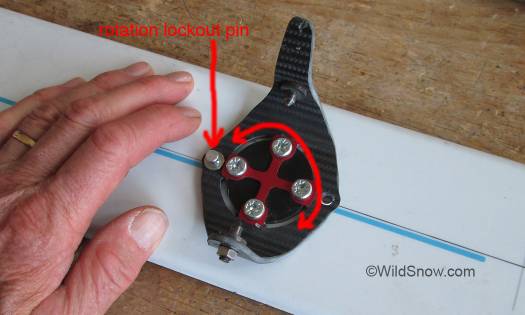
Gignoux toe (57 grams with screws, one binding toe) is what I feel is the most beautiful part of the whole contraption. You can tell the composite was hand shaped to some degree, with all the spring action holding your boot in being provided by deflection of the composite. With my Dynafit TLT-6 boots I was able to enter the binding with a tricky step-in motion that took some experimentation. To exit you just bend the obvious tab. The interesting thing here is that the binding is toe is configured so as to ‘turntable’ rotates and give a smooth lateral release in downhill mode. Problem is, you can’t go uphill with a free heel with the turntable active, so Gignoux provides a small threaded pin (shown with arrow) that screws through the binding into the ski to lock out all rotation. For ski touring this is tedious at best, hence I experimented by running the binding with the turntable locked out. This worked with conventional tech fittings that are designed with a taper so as to ride off the binding pins for smooth release. Gignoux boot is different, see next photo.
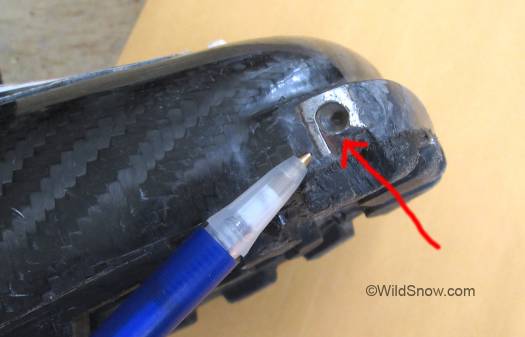
Gignoux boot toe has a somewhat primitive looking tech fitting, but it works well with their binding. The idea is that the lead-in notch shown with arrow engages the binding pins when you step directly down (see embedded video below). It works quite well, you pop in directly downwards with a reassuring ‘snap’ and have no discernible lateral release function unless the toe unit turntable action is enabled by removing the tiny lockout pin shown in photo above.
I used a conventional tech boot (TLT6) in the binding as an experiment. I found this configuration to have a modicum of safety release (without turntable function in toe) but would not make it my daily driver for ski touring (if for no other reason than lack of heel lift in climbing mode).
Switching to the Gignoux boot yielded results with a more “integrated” feeling and reasonable heel lift for moderate climbing angles, yet conversely the boot had virtually no lateral release unless the toe turntable function was enabled.
Problem: no way in a race situation are you going to be screwing and unscrewing the tiny pin used to lock out turntable action in the binding toe. Even while ski touring this seems to be a system that would be prone to loss of the pin, as well as being difficult to manipulate in full conditions. In other words, good uses for the Gignoux Ultimate 2 system would be “vertical” time trial type skimo racing when weight is of essence and mode changes are not a big factor. Or, ski touring with either no release enabled or willingness to fiddle with the tiny lockout pin. What’s more, both inserting and backing out our lockout pin required inserting a tiny handle/rod we improvised from a drill bit. We’re not convinced this would be very friendly in the backcountry.
Note the Gignoux boot does function to some degree in a conventional tech binding. But due to shape of the tech fittings in the toe it has no lateral release unless the tech binding has a turntable function. Certain Dynafit models will have this function by next season.
One of the ongoing problems with the current state-of-art tech binding system is that unless the boot toe fittings are perfectly shaped, you can get sticky or zero lateral safety release. Next winter, you’ll begin seeing Dynafit bindings that allow the toe unit to rotate (turntable) in lateral release (Beast model already has this feature). I’m optimistic that such rotating toe units will reduce the criticality of how tech binding boot toe sockets are shaped — thus helping the industry as a whole. On the other hand, no engineering change in a machine is without consequence. I’d encourage all you guys who tend to be “early adopters” to be leery of how the new turntable bindings are going to perform in real life. Beast model seems to be doing well, but lighter weight models designed for touring and racing must meet different needs.
You can’t argue the simplicity and elegance of the classic tech binding configuration. Any changes to the basic configuration could indeed be solutions without problems.
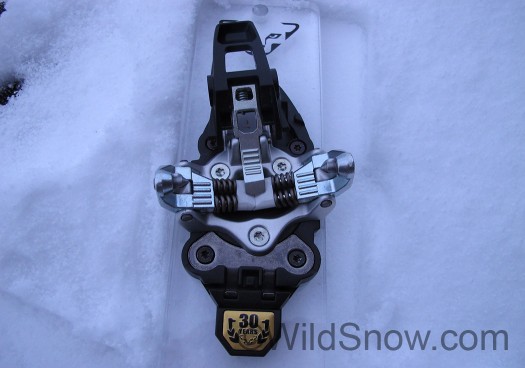
Rotating turntable toe unit on Dynafit Radical 2.0 may increase binding safety, or solution without problem? At the least, this may enable use of Gignoux boots by enabling full safety release.
By the way, they have some Vapor Nano skis at Cripple Creek Backcountry. Shop for ’em.
WildSnow.com publisher emeritus and founder Lou (Louis Dawson) has a 50+ years career in climbing, backcountry skiing and ski mountaineering. He was the first person in history to ski down all 54 Colorado 14,000-foot peaks, has authored numerous books about about backcountry skiing, and has skied from the summit of Denali in Alaska, North America’s highest mountain.
